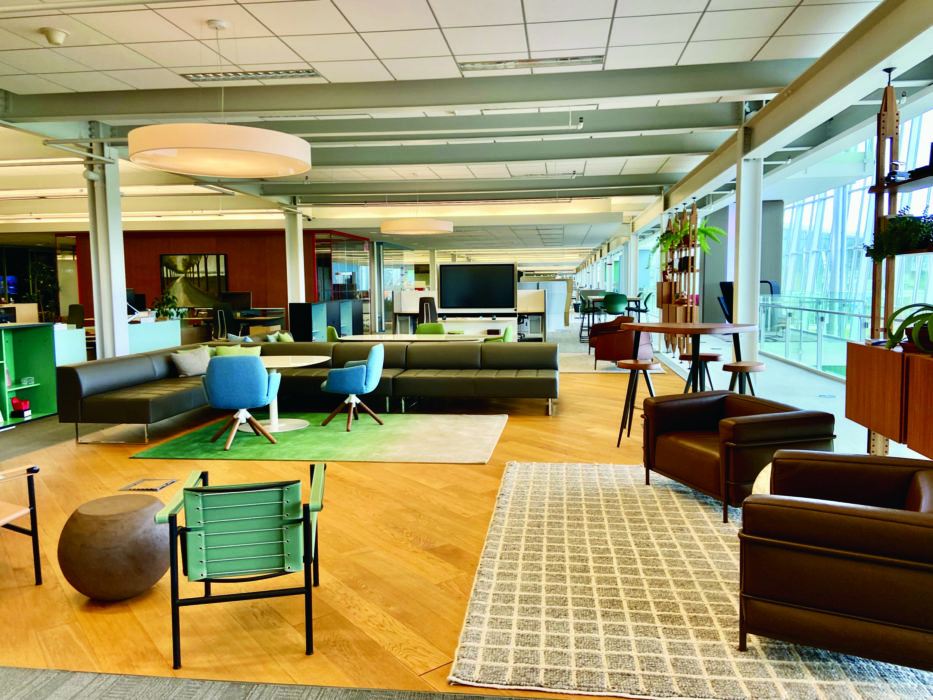
The Future of the Office Work Environment:
How the COVID Pandemic Fundamentally Changed the Workplace
May 9, 2022
Originally featured in SBAM’s FOCUS Magazine
The global pandemic forced most employers to send their employees home to work remotely, and companies had to go from zero to 60 to figure out how to run their businesses with their teams indefinitely out of the office. We should keep in mind that this seismic shift in the modern workplace occurred in just over two years.
Overall, though, our modern offices have changed very little over time.
Here is how our offices have evolved in the last 70 years:
1950-1960: The office was based on the factory workplace paradigm—the office looked like manufacturing floors with rows of desks.
1970-1990: Computers were introduced. Freestanding desks evolved into cubicles and the office was transformed by hard-wired technology requiring a monitor and CPU.
2000-2020: We went to the office because that was where our work was. Wi-Fi and mobile technology allowed us to be untethered from our desks.
2020- beyond: Work from anywhere. The pandemic forced us out of the office and became a catalyst to change the way we view the office and work.
One thing that most modern workplace experts agree on is that pre-pandemic work environments are a thing of the past. Two years ago, we had never heard of Zoom and now being in a virtual meeting is second nature.
As a Haworth Best in Class Dealer we have access to the Michigan-based global office interiors corporations’ vast knowledge base. They are breaking down the workplace into three segments as part of their work from anywhere theme. When employees have a choice, they are prone to work in the places that make them feel the best and most productive.
Work from Home
The remote workspace has become a key part of the hybrid employee schedule. The value of remote work is a key tool for managing risk while maintaining business continuity.
The Office
Collaboration is at the top of the list as to why the office is still vital to a company’s future. Social interaction spurs innovation and creativity. Mentoring happens best in-person, and the office is where your employees learn the culture of the business.
A Third Place
Think of the other places where you can collaborate with your team—the coffee shop, library, community work hubs. We are even seeing companies build and create their own internal spaces that mirror the local coffee shop.
Today, there are many companies creating their return-to-work policies. Collaboration spaces will be vital as the needs and the number of returning employees changes. Having spaces that encourage collaboration will be key, and all these spaces should be immersive, meaning there should be technology on hand.
Technology will continue to improve the workplace experience in these different work zones. Internet speeds and camera technology for video meetings continues to improve. And software is becoming more robust, allowing employees to share tasks, documents and reminders.
As the transition back to the office takes place, awareness of the shifting space requirements is important. There will need to be more group space, as well as more space where an employee can rejuvenate and recover. We need to acknowledge that these last 24 months have been stressful, and all of us have had to adapt to a new reality.
Finding balance will be key to keeping the workplace healthy and competitive. Maintaining employee happiness and being able to attract new talent is more important than ever. With the work from anywhere model, we are competing for talent with businesses outside of our cities and even our state. The goals should be to help make your people more effective and the real estate more efficient.
Listening to your employees is critical to ensure the hybrid environment works. Both managers and employees should be transparent in their communications and understanding of hybrid plans. Having access to communications is essential. All employees must receive the same information at the same time.
Being flexible and continuing to adapt will be key in how modern office space develops. In this short span of two years, we have experienced global scale disruptions that only movies are made of. Monitoring the health and well-being of all our employees is essential as we learn and move forward.
Jim Davis is an experienced marketing professional with a dynamic career, gaining his experience across businesses, functions and industries.
Jim’s second job has been sports marketing and event management. He’s also a mountain bike early adapter and currently is part of a dynamic team running the youth mountain bike league in Michigan (MiSCA). Jim is a Michigan State alum and has been married 29 years.